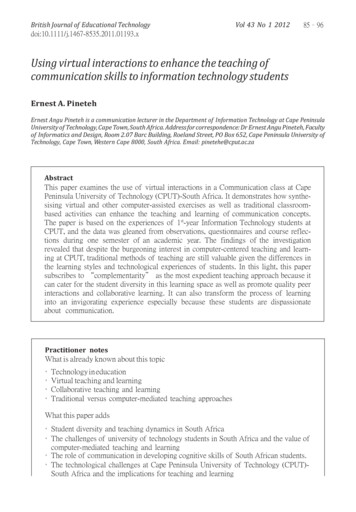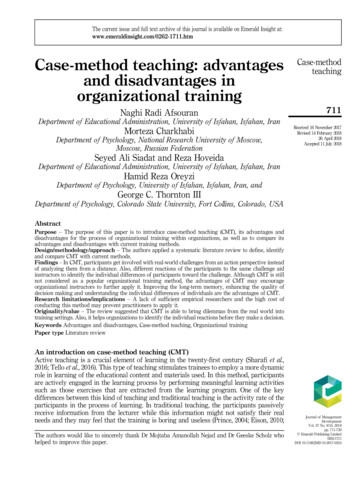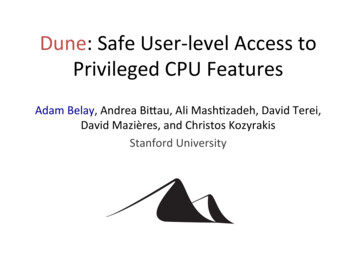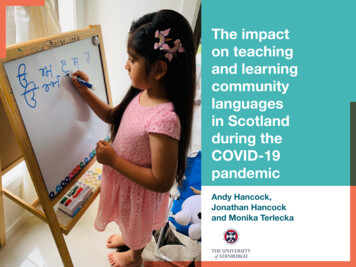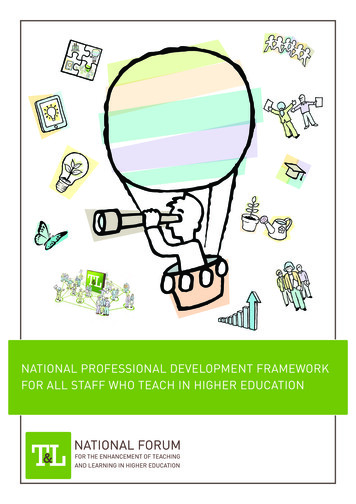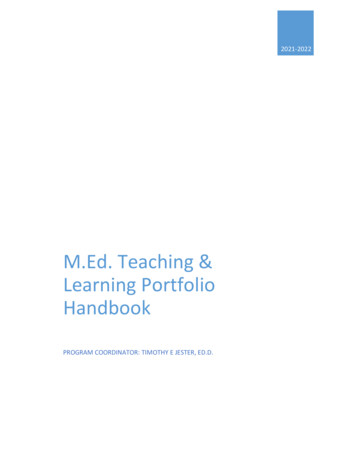
Transcription
2021-2022M.Ed. Teaching &Learning PortfolioHandbookPROGRAM COORDINATOR: TIMOTHY E JESTER, ED.D.
M.Ed. T/L Portfolio HandbookFall 2021M.Ed. Teaching and LearningPortfolio HandbookContentsSection 1:Portfolio OverviewSection 2:Portfolio DirectionsSection 3:Phases of EDTL A698Appendices Appendix A: Portfolio Evaluation FormDisclaimer as required by UAA Office of Academic Affairs:This handbook is provided for informational purposes only and should not be construed as the basis of a contractbetween a student and the University of Alaska Anchorage. Although every effort is made to ensure itscorrectness, regulations of the university and this program’s requirements change from time to time during theperiod any student is attending the University of Alaska Anchorage; to the extent there is a conflict between thishandbook and university policies, regulations, rules, or procedures, the university policies, regulations, rules, orprocedures will control.1
M.Ed. T/L Portfolio HandbookFall 2021SECTION 1OVERVIEWM.Ed. Teaching and Learning PortfolioThe Teaching and Learning Portfolio is the culminating project in the M.Ed. in Teaching and Learningprogram. Through the portfolio, students demonstrate attainment of the five Program Student LearningOutcomes (PSLO) (see list below), which are aligned with the Alaska Cultural Standards for Educatorsand the CPED Principles for Program Design. Students demonstrate enactment of each PSLO at leastthree times across the portfolio.The portfolio consists of four parts developed through independent work and enrollment in threephases of EDTL A698, Teaching and Learning Research Project:1)2)3)4)Research Project ReportArtifact ReportPersonal ReflectionOral PresentationStudents submit the final portfolio in Phase 3 of EDTL A698. See Section 3 of the Portfolio Handbook fora description of the three phases.ORGANIZING FRAMEWORK:PROGRAM STUDENT LEARNING OUTCOMES, CPED DESIGN PRINCIPLES, AND ALASKA CULTURAL STANDARDS FOREDUCATORSThe M.Ed. Teaching and Learning program is designed to support students’ development of five ProgramStudent Learning Outcomes (PSLO)1. Demonstrate advanced content and pedagogical knowledge for teaching.2. Use research to inform professional practice.3. Explain the relationship between education and social justice.4. Demonstrate leadership skills for the professional context.5. Translate educational theories into culturally responsive practice.The Program Student Learning Outcomes encompass knowledge, skills, and dispositions needed tofunction as scholarly practitioner, whether in P-12 schools or other educational settings. The M.Ed.Teaching and Learning portfolio aligns the PSLOs with the Carnegie Project on the Education Doctorate’s(CPED) Guiding Principles for Program Design and the Alaska Cultural Standards for Educators. Below ismore information about the CPED principles and the Alaska Cultural Standards for Educators, including atable that summarizes alignment of these elements in the M.Ed. Teaching and Learning’s organizingframework.2
M.Ed. T/L Portfolio HandbookFall 2021Definition of Key Terms, Principles, and StandardsAlaska Cultural Standards for Educators:A. Incorporate local ways of knowing and teaching in their work.B. Use the local environment and community resources to link teaching to everyday lives ofstudents.C. Participate in community events and activities in appropriate and supportive ways.D. Work closely with parents [or other partners] to achieve high level of complementaryeducational expectation between home/community and school/organization.E. Recognize full education potential of each student and provide conditions necessary forthem to achieve [realize] that potential.(Retrieved from .pdfCPED Guiding Principles for Program Design in the M.Ed. Teaching and Learning program Framed around questions of equity, ethics, and social justice to bring about solutions to complexproblems of practice. Prepares leaders who can construct and apply knowledge to make a positive difference in thelives of individuals, families, organizations, and communities. Provides opportunities for candidates to develop and demonstrate collaboration andcommunication skills to work with diverse communities and to build partnerships. Grounded in and supports development of a professional knowledge base that integrates bothpractical and research knowledge, that links theory with systemic and systematic inquiry. Emphasizes the generation, transformation, and use of professional knowledge and practice.(Retrieved from page AboutUs )Scholarly Practitioner: Scholarly Practitioners blend practical wisdom with professional skills andknowledge to name, frame, and solve *problems of practice. They use practical research and appliedtheories as tools for change. (Retrieved asp?page AboutUs )*Problem of Practice: A Problem of Practice is a persistent, contextualized, and specific issue embeddedin the work of a professional practitioner, the addressing of which has the potential to result inimproved understanding, experience, and outcomes. (Retrieved asp?page AboutUs )3
M.Ed. T/L Portfolio HandbookFall 2021Organizing Framework of M.Ed. Teaching and Learning PortfolioM.Ed. Teaching and Learning PSLOs1) Demonstrate advanced content andpedagogical knowledge for teaching.2) Use research to inform professionalpractice.3) Explain the relationship betweeneducation and social justice.4) Demonstrate leadership andfacilitation skills for the professionalcontext.5) Translate educational theories intoculturally responsive practice.CPED Principles for Program DesignEmphasizes the generation, transformation,and use of professional knowledge andpractice.Grounded in and develops a professionalknowledge base that integrates bothpractical and research knowledge, that linkstheory with systemic and systematic inquiry.Framed around questions of equity, ethics,and social justice to bring about solutions tocomplex problems of practice.Prepares leaders who can construct andapply knowledge to make a positivedifference in lives of individuals, families,organizations, and communities.Opportunities to develop and demonstratecollaboration and communication skills towork with diverse communities and to buildpartnerships.Alaska Cultural Standards for EducatorsStandards A, B, and E infused with content andpedagogical knowledge specific to one’sprofessional fieldStandard B as one component of datainformed, research-based professional practiceStandard E as one component of social justiceeducationStandard C as one component of leadershipA. Incorporate local ways of knowing andteaching and their work.B. Use the local environment and communityresources to link teaching to everyday lives ofstudents.C. Participate in community events andactivities in appropriate and supportive ways.D. Work closely with parents [or otherpartners] to achieve high level ofcomplementary educational expectationbetween home/community andschool/organization.E. Recognize full education potential of eachstudent and provide conditions necessary forthem to achieve that potential.4
M.Ed. T/L Portfolio HandbookFall 2021SECTION 2PORTFOLIO DIRECTIONSThe portfolio consists of four parts developed through independent work with faculty support duringthree phases of EDTL A698, Teaching and Learning Research Project. In the final portfolio, students mustdemonstrate enactment of each Program Student Learning Outcome at least three times across thethree written sections of the portfolio. The four parts are:Part 1: Research Project ReportPart 2: Artifact ReportPart 3: Personal ReflectionPart 4: Oral PresentationSection 2 of the Portfolio Handbook provides information about each section of the portfolio andexplains directions for preparing and presenting the final portfolio in Phase 3.Portfolio Part 1Research Project ReportDirectionsResearch Project SummaryM.Ed. Teaching and Learning students conduct an applied research project that addresses a problem ofpractice (PoP) relevant to the student’s professional practice. The project is developed and implementedin Phases 1 and 2 of EDTL A698 and submitted with the program portfolio in Phase 3.The research project incorporates the Alaska Cultural Standards for Educators and CPED’s GuidingPrinciples for Program Design to support students’ development as scholarly practitioners for the Alaskacontext. The M.Ed. Teaching and Learning program has adapted the CPED approach for a master’s levelresearch project. See Section 1 of the Portfolio Handbook for information about the CPED principles,scholarly practitioner, and the Alaska Cultural Standards for Educators.Examples of Applied Research Projects in the M.Ed. Teaching and Learning programThrough work in Phases 1 and 2, students design and implement an applied research project. In Phase 3,students draw from their work in prior phases to complete the research report.The research method(s) (e.g., qualitative, quantitative, mixed-mode, etc.) should be appropriate foraddressing the research question and relevant to the identified problem of practice. Students explicitlyshow/explain the links among the elements of the project as they work through the three Phases ofEDTL A698.The following are examples of M.Ed. Teaching & Learning research projects completed by graduates:5
M.Ed. T/L Portfolio HandbookFall 2021 Action Research: Study of teacher’s work with students’ parents in a diverse,multicultural/multilingual middle school leading to an action plan for enhancing and deepeningparents’ participation in their children’s education. Curriculum: Research-based curriculum unit for a rural Alaska school district’s middle schoolmath and science curriculum. Integrated a place-based/culturally responsive model with theCommon Core standards. Professional Manual for Teachers: Study of outdoor education using a place-based frameworkresulting in a manual for teachers to use in curriculum planning. Curriculum: Research-based middle school curriculum aligning a national curriculum to theAlaska Standards for Language Arts and Math. Professional Manual for Teachers: Action research examining teacher’s practice with positivebehavior intervention program leading to the development of a framework used in aprofessional manual for teachers working in general education preschools.6
M.Ed. T/L Portfolio HandbookFall 2021Research Project Report: Directions for each sectionFinal report due in Phase 3 of EDTL A698The applied research report should reflect high levels of professionalism, rigor in scholarship, andrelevancy in addressing an authentic problem of practice. Written presentation and all formatting (e.g.,citations) should follow APA Style (7th ed.), unless otherwise noted.The applied research report consists of the sections below. Include headings and subheadingsthroughout the research report.1. Title Page—use APA style unless the Instructor of EDTL A698 designates a different structure.2. Abstract (150-250 words) See APA Style Manual (7th ed.) for information about abstracts. In theabstract, clearly identify the problem of practice, research question, methods, findings,professional product (if applicable), and implications for practice.3. Executive Summary (1-2 pages)Identify the major sections of the research report using subheadings as noted below. Eachsection in the Executive Summary is a concise summary of that section in the report. Useheadings as listed below.a. Problem of Practice: Identify the problem of practice and concisely state i) how it isembedded in profesional practice; (ii) its persistence over time; (iii) the context in whichit is sitauted; and (iv) the potential for improving understanding, experience, oroutcomes by addressing it in your research project. (2-3 sentences)b. Research Question: Present the research question and briefly explain how it relates tothe problem of practice. (2-3 sentences)c. Theoretical or Conceptual Framework: Identify and concisely explain the theoretical orconceptual framework used in the research project. (2-3 sentences)d. Literature Review: Identify the key themes and briefly explain the relationship of thethemes to the problem of practice, research question, and the professional product. (23 sentences)e. Methods: Identify the sample (participants) and methods used to conduct the researchand analzye the data. (2-3 sentences)f.Contribution to Professional Practice: Findings or Professional Product: Identify themajor findings or the research-based professional product. State how the findings orprofessional product relate to the problem of practice? (2-3 sentences)g. Discussion: Implications for Practice and the Profession/Field: Identify and summarizethe major themes/ideas in the discusison section. (2-3 sentences)7
M.Ed. T/L Portfolio HandbookFall 20214. Problem of Practice (2-3 pages)Explain the importance of the problem of practice—e.g., to the field, profession, your practiceand/or your organization—and how the research project addresses it. Clearly respond to thefollowing items in the order presented below, listing each as a subheading. References topersonal experience is acceptable but there should also be citations from thereseach/professional literature when applicable. Specfic problem (or issue or challenge)Embedded in professional practicePersistence over timeContext (e.g., social, cultural, political, historical).Potential to improve understanding, experiences, or outcomes5. Research Question (1-2 paragraphs)Present the research question and explain how it relates to the problem of practice.6. Theoretical or Conceptual Framework (1-2 pages)Identify the theoretical or conceptual framework used in the research project and explain why itis appropriate for—or relevant to—your research project. Include citations from relevant texts.7. Literature Review (4-8 pages)Present and discuss relevant scholarly literature related to the research project. In theintroduction to this section, succiently state how the themes in the literature review relate tothis specific research project (e.g., problem of practice, reseach question). Clearly identifythemes and use subheadings to organize the literature review. Written presentation should flowsmoothly and reflect conventions of academic writing appropriate for graduate level work. UseAPA style (7th edition) for citations, notes, etc.8. Methods (1-3 pages)Describe in detail how the research project was conducted. Explicitly explain how the methodsrelate to and appropriately address the research question. Divide into subsections with headingsappropriate for the type of research you conducted. Examples of subsections include sample,data collection, and data analysis. If you used a data collection instrument (e.g., survey,interview protocol), include it in the appendix or the report. (Do not present findings in themethods section.)9. Contrubution to Professional Practice: Findings or Professional Product (Length: Variesdepending on type of product)Present the research findings or the research-based professional product in this section. In theintroduction to this section, concisely restate how the research project addresses the problemof practice and offers a positive contribution to professional practice. If you prepared aresearch-based professional product (e.g., curriculum), in the introduction of this section clearlyidentify the findings of your research and explain how these findings informed the developmentof and otherwise are incorporated in the professional product.8
M.Ed. T/L Portfolio HandbookFall 202110. Discussion: Implications for Practice and the Profession (3-6 pages)Present implications of the research project for your professional practice and the profession.Use subheadings as indicated below. Clearly address implications for your individual practiceand for the broader professional field (e.g., school, school district, or organization). Whenaddressing implementation beyond your individual professional practice, demonstrate thecapacity to think as a leader in the field. Use the following subheadings and points/questions toorganize the discussion:oPersonal Professional Practice: How will you use the findings or professional product inyour individual professional practice? (1-3 pages)oImplications for the Profession: Demonstrate your capacity to think as a leader in thefield by addressing one or more of the following questions: (2-3 pages)a) What would need to happen for your professional product or findings to beimplementated on a broader scale (e.g., district or state-wide)?b) What are policy implications of your findings or product?c) What are implications for professional education (e.g., preservice teachereducation) or continuing education opportunities/professionaldevelopment?11. ReferencesUse APA style (7th ed.) and include all citations in the research report.12. End Notes (if applicable)13. Appendix (if applicable)9
M.Ed. T/L Portfolio HandbookFall 2021Portfolio Part 2Artifact ReportThe primary purpose of the Artifact Report is to present evidence of—i.e., make the case for—havingmet the Program Student Learning Outcomes (PSLO). Present two (2) artifacts for each PSLO with a totalof 10 artifacts in the report. Do not include more than two (2) artifacts for each PSLO. The same artifactmay be used for up to two PSLOs; however, at least five separate/individual artifacts must be included inthe Artifact Report.Artifacts will be selected from two sources: (a) assignments in classes completed in courses that werepart of the program of study and (b) professional practice during the time admitted to the M.Ed.Teaching and Learning program. Examples of professional practices include leading a professionaldevelopment workshop for colleagues or serving on a curriculum review committee for a school orschool district.The Artifact Report consists of a cover page, summary table, and Parts A and B, explained below.Cover Page: Include the following information:1)2)3)4)5)6)Student NameTitle: M.Ed. Teaching and Leanring Portfolio Part 2: Artifact ReportProgram: M.Ed. Teaching and LearningCourse: EDTL A698—Phase 3Name of InstructorDate SubmittedAfter the cover page, insert the Artifact Summary Table as page 2 of the Artifact Report—see templatein at the end of this section in the handbook.Part A: Artifact Report: Linking Artifacts to PSLOThe Artifact Report will be structured around the Program Student Learning Outcomes (PSLO) andclearly address the three guiding questions for each PSLO: What, So What, Now What?When using one artifact for two PSLOs, address each set of questions twice, specific to each PSLO.Part B: Artifact Documentation:In Part B, document completing the artifact identified in Part A—i.e., the actual assignment orprofessional product you referred to in Part A.Include all headings, subheadings, and format presented below for Parts A and B.10
M.Ed. T/L Portfolio HandbookFall 2021Artifact Report Part A:Linking Artifacts to Program Student Learning Outcomes(Total of 10 artifacts—for more information, see above)Organize the Artifacts Report by the Program Student Learning Outcomes with clear headings forsections in Part A of the Artifacts Report:PSLO 1: Content and InstructionPSLO 2: Research Informing PracticePSLO 3: Social Justice and EducationPSLO 4: LeadershipPSLO 5: Culturally Responsive PracticeFormat and Headings for Each Artifact (Total 10): Indicate the exact PSLO by number and title, seeprevious paragraph. Include the three guiding questions as subheadings for each of the 10 artifacts:PSLO #: Title of PSLONumber and Name Artifact: (e.g., Artifact #1, Curriculum Design)Course: List Course Prefix, Number, and Title (e.g., EDTL A651: Curriculum Theory and Design)What? Identify the artifact (name of artifact) and describe main features. Provide enough detailthat the reader can visualize the main features of the artifact without looking at the actual item.(1 paragraph: 3-5 sentences)So What? Clearly explain how this artifact demonstrates attainment of the PSLO. Include anexample or two that illustrate how you enacted the PSLO. In this section, it is imperative tomake a strong case that this artifact shows enactment of associated PSLO. (1-2 paragraphs: 3-5sentences per paragraph)Now What? Tell about one implication for your professional practice in the future. This shouldclearly focus on your future practice. (1 paragraph—3-5 sentences)Artifact Report B: Artifact DocumentationDirections: Use the following format for each of the 10 artifacts referenced in Part A.Artifact 1: Provide Name and Number of Artifact and List the PSLO. Include the artifact.Artifact 2: Provide Name and Number of Artifact and List the PSLO. Include the artifact.Artifact 3: Provide Name and Number of Artifact and List the PSLO. Include the artifact.Artifact 4: Provide Name and Number of Artifact and List the PSLO. Include the artifact.11
M.Ed. T/L Portfolio HandbookFall 2021Artifact 5: Provide Name and Number of Artifact and List the PSLO. Include the artifact.Artifact 6: Provide Name and Number of Artifact and List the PSLO. Include the artifact.Artifact 7: Provide Name and Number of Artifact and List the PSLO. Include the artifact.Artifact 8: Provide Name and Number of Artifact and List the PSLO. Include the artifact.Artifact 9: Provide Name and Number of Artifact and List the PSLO. Include the artifact.Artifact 10: Provide Name and Number of Artifact and List the PSLO. Include the artifact.12
M.Ed. T/L Portfolio HandbookFall 2021M.Ed. Teaching and Learning Portfolio (EDTL A698)Artifacts SummaryName:Date:Program StudentLearning Outcomes(PSLO)1: Content & InstructionArtifact Number & TitleIdentify Course orProfessional Practice Event2: Research informingPractice3: Social Justice &Education4: Leadership5: Culturally ResponsivePracticeNote: The above table should be complete and placed as page 2 of the Artifact Report.13
M.Ed. T/L Portfolio HandbookFall 2021Portfolio Part 3Personal ReflectionLength: 4-6 pagesCompleted in Phase 3 of EDTL A698.Include a Cover Page with the following information: Student NameTitle: M.Ed. Teaching and Learning Portfolio Part 3: Personal ReflectionProgram: M.Ed. Teaching and LearningCourse: EDTL A698—Phase 3Name of InstructorDate SubmittedDirections: Write a respond to the prompts below. Clearly identify each response with a heading basedon the prompts below.Prompt 1: Personal Learning Outcomes (2-3 pages)Considering overall experiences in the M.Ed. Teaching and Learning program, write a personal reflectionthat presents key personal learning outcomes. Students are encouraged to make connections to the fiveProgram Student Learning Outcomes, if possible.Prompt 2: Culturally Responsive Educator (2-3 pages)a) Describe yourself as a culturally responsive educator.b) Do you attribute experiences in the M.Ed. Teaching and Learning program as having supportedyour development as a culturally responsive educator? If yes, provide examples of how thissupport occurred. If no, explain.14
M.Ed. T/L Portfolio HandbookFall 2021Portfolio Part 4Oral PresentationThe instructor in EDTL A698—Phase 3 will announce the due date of the oral presentation eachsemester. The oral presentation serves as the program’s oral comprehensive exam. Students present asummary of the three sections of the portfolio as explained in the information below.ePresentation: The presentation is typically produced as a video recording. The instructor of EDTL A698will inform students of the recording format used in a specific semester at the beginning of the Phase 3semester.Presentation OutlineIntroduction (5 minutes) Who are you? (e.g., classroom teacher )M.Ed. T/L Professional ConcentrationAdvance organizer for presentation (e.g., what is the order of the presentation)Personal Reflection (10-15 minutes)Present summary of key personal learning during graduate program and describe yourself as a culturallyresponsive educator.Research Report (10-15 minutes)Present a concise summary of each section. Problem of PracticeResearch QuestionConceptual or Theoretical FrameworkLiterature Review (Identify a key theme or two from lit. review emphasizing how lit reviewrelated to or informed your project)Methods (e.g., What type of research and why this type?)Contribution to Professional Practice: Findings or Research-based Professional ProductDiscussion: Implications for Professional Practice and the ProfessionConcluding remarksArtifacts Summary (10-15 minutes)Select four or five (4 or 5) of the 10 artifacts from the Artifact Report. Include the following informationfor each: Source of Artifiact: Course or Professional Practice (one may be from professional practice)Link to Program Student Learning OutcomeAddress the three questions in the Artifact Written Report: What, So What, Now What?Questions/Debrief: Address questions posed by faculty reviewers, as requested. This process may occurvia a scheduled debrief conference call—e.g., phone, Collaborate, or Skype—or in writing.15
M.Ed. T/L Portfolio HandbookFall 2021Section 3EDTL A698: Three PhasesDesigning, Implementing, and CompletingOverviewEDTL A698: Teaching and Learning Research Project supports M.Ed. Teaching and Learning students indeveloping the program portfolio. Students enroll in EDTL A698 three times for one credit each time(total credits 3).Students use knowledge and skills gained in research methods courses and through independentreading/study to design and implement a research project with support from the EDTL A698 instructor.EDTL A698 is not a research methods course. For more information about the Research Project, see thecurrent version of the M.Ed. Teaching and Learning Portfolio Handbook.The EDTL A698 instructor facilitates and otherwise supports the research project and portfoliodevelopment process. However, the instructor is not an expert in all content areas or professional fieldsthat students will be examining in research projects. If a student needs additional support from acontent or professional expert, it is the student’s responsibility to identify and arrange to consult withthat individual (e.g., university faculty or professional in the field).The following is a summary of the three phases of EDTL A698.Phase 1: Designing (First credit of EDTL A698)Primary Products: Research Project Proposal, Artifact Report 1, IRB CertificationStudents enroll for the first credit of EDTL A698 prior to completing an approved research projectproposal. To enroll in EDTL A698, students must be fully admitted to the M.Ed. T/L program; they alsomust have successfully completed EDRS A660 or, with permission, be enrolled in EDRS A660 during thesame semester.Instructor approval of the Research Project Proposal and passing all other assignments are required topass EDTL A698—Phase 1.In addition to the products noted above, Phase 1 exposes T/L students to the Program Student LearningOutcomes and the Alaska Cultural Standards for Educators.Phase 2: Implementing (Second credit of EDTL A698)Primary Products: Literature Review, Research Status Reports 1 & 2, and Artifact Report 2Phase 2 is usually the *second time students enroll in EDTL A698 for one credit. Phase 2 students arelikely in various stages of the research project process. For example, some students may be beginning toimplement the proposal approved in Phase 1 while others may be implementing their researchproject. At a minimum, students enter Phase 2 ready to implement the proposal that was approved inPhase 1.16
M.Ed. T/L Portfolio HandbookFall 2021*In some cases, students may be considered Phase 2 who have already completed two or more creditsof EDTL A698 but are not yet ready to move into Phase 3, as described below.Phase 3: Completing—Final Credit of EDTL A698Primary Product: Final Portfolio—all sectionsStudents complete the Program Portfolio in Phase 3. The final portfolio is the primary product in Phase3. Students must pass the final portfolio—written version and oral presentation—to pass EDTL A698,Phase 3 and to meet the M.Ed. Teaching and Learning portfolio requirement.Written PortfolioAll research, including data collection, analysis, findings, and the professional product—if applicable—should be completed before enrolling in Phase 3. Students submit a draft of the Research Project Reportand Artifact Report to the instructor early in the semester and then revise for the final submission thatincorporates instructor’s feedback. Due dates are set by the instructor of EDTL A698 each semester. It isexpected that students submit a well-written, clean, and complete draft of the Research Project Reportand Artifact Report and meet the deadlines published in the syllabus of EDTL A698.The final portfolio will include three written sections—Research Project Report, Artifact Report, andPersonal Reflection—that demonstrate attainment of the five Program Student Learning Outcomes.Oral PresentationThe instructor in EDTL A698—Phase 3 announces the due date for the oral presentation each semester.The oral presentation is typically produced as a video recording posted on Bb. The instructor of EDTLA698 will inform students of the recording format used in a specific semester at the beginning of thePhase 3 semester.Evaluation Process for written portfolio and oral presentationStudents demonstrate having attained the five Program Student Learning Outcomes via the portfolio.The written portfolio and the oral presentation are evaluated by the instructor of EDTL A698. In somecases, the portfolio may be reviewed and evaluated by another UAA/SOEd faculty. The portfolio isevaluated based on criteria described in the Portfolio Handbook for each section of the portfolioincluding (a) Research Report, (b) Artifact Report, (c) Personal Reflection, and (d) Oral Presentation.Instructor’s ap
The Teaching and Learning Portfolio is the culminating project in the M.Ed. in Teaching and Learning program. Through the portfolio, students demonstrate attainment of the five Program Student Learning . Teaching and Learning portfolio aligns the PSLOs with the Carnegie Project on the Education Doctorate's (CPED) Guiding Principles for .




